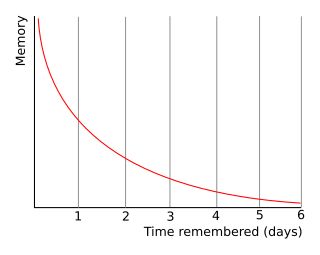Related Research Articles

Forgetting or disremembering is the apparent loss or modification of information already encoded and stored in an individual's short or long-term memory. It is a spontaneous or gradual process in which old memories are unable to be recalled from memory storage. Problems with remembering, learning and retaining new information are a few of the most common complaints of older adults. Studies show that retention improves with increased rehearsal. This improvement occurs because rehearsal helps to transfer information into long-term memory.

The forgetting curve hypothesizes the decline of memory retention in time. This curve shows how information is lost over time when there is no attempt to retain it. A related concept is the strength of memory that refers to the durability that memory traces in the brain. The stronger the memory, the longer period of time that a person is able to recall it. A typical graph of the forgetting curve purports to show that humans tend to halve their memory of newly learned knowledge in a matter of days or weeks unless they consciously review the learned material.

A mnemonicdevice, or memory device is any learning technique that aids information retention or retrieval (remembering) in the human memory for better understanding.
The mnemonic peg system, invented by Henry Herdson, is a memory aid that works by creating mental associations between two concrete objects in a one-to-one fashion that will later be applied to to-be-remembered information. Typically this involves linking nouns to numbers and it is common practice to choose a noun that rhymes with the number it is associated with. These will be the pegs of the system. These associations have to be memorized one time and can be applied repeatedly to new information that needs to be memorized.
Recall in memory refers to the mental process of retrieval of information from the past. Along with encoding and storage, it is one of the three core processes of memory. There are three main types of recall: free recall, cued recall and serial recall. Psychologists test these forms of recall as a way to study the memory processes of humans and animals. Two main theories of the process of recall are the two-stage theory and the theory of encoding specificity.
Memorization is the process of committing something to memory. It is a mental process undertaken in order to store in memory for later recall visual, auditory, or tactical information.

The testing effect suggests long-term memory is increased when part of the learning period is devoted to retrieving information from memory. It is different from the more general practice effect, defined in the APA Dictionary of Psychology as "any change or improvement that results from practice or repetition of task items or activities."
In cognitive psychology, chunking is a process by which small individual pieces of a set of information are bound together to create a meaningful whole later on in memory. The chunks, by which the information is grouped, are meant to improve short-term retention of the material, thus bypassing the limited capacity of working memory and allowing the working memory to be more efficient. A chunk is a collection of basic units that are strongly associated with one another, and have been grouped together and stored in a person's memory. These chunks can be retrieved easily due to their coherent grouping. It is believed that individuals create higher-order cognitive representations of the items within the chunk. The items are more easily remembered as a group than as the individual items themselves. These chunks can be highly subjective because they rely on an individual's perceptions and past experiences, which are linked to the information set. The size of the chunks generally ranges from two to six items but often differs based on language and culture.

The method of loci is a strategy for memory enhancement, which uses visualizations of familiar spatial environments in order to enhance the recall of information. The method of loci is also known as the memory journey, memory palace, journey method, memory spaces, or mind palace technique. This method is a mnemonic device adopted in ancient Roman and Greek rhetorical treatises. Many memory contest champions report using this technique to recall faces, digits, and lists of words.
The title mnemonist refers to an individual with the ability to remember and recall unusually long lists of data, such as unfamiliar names, lists of numbers, entries in books, etc. Some mnemonists also memorize texts such as long poems, speeches, or even entire books of fiction or non-fiction. The term is derived from the term mnemonic, which refers to a strategy to support remembering, but not all mnemonists report using mnemonics. Mnemonists may have superior innate ability to recall or remember, in addition to relying on techniques.
Self-referential encoding is a method of organizing information in one's memory in which one interprets incoming information in relation to oneself, using one's self-concept as a background. Examples include being able to attribute personality traits to oneself or to identify recollected episodes as being personal memories of the past. The implications of self-referential processing are evident in many psychological phenomena. For example, the "cocktail party effect" notes that people attend to the sound of their names even during other conversation or more prominent, distracting noise. Also, people tend to evaluate things related to themselves more positively. For example, people tend to prefer their own initials over other letters. The self-reference effect (SRE) has received the most attention through investigations into memory. The concepts of self-referential encoding and the SRE rely on the notion that relating information to the self during the process of encoding it in memory facilitates recall, hence the effect of self-reference on memory. In essence, researchers have investigated the potential mnemonic properties of self-reference.
Memory has the ability to encode, store and recall information. Memories give an organism the capability to learn and adapt from previous experiences as well as build relationships. Encoding allows a perceived item of use or interest to be converted into a construct that can be stored within the brain and recalled later from long-term memory. Working memory stores information for immediate use or manipulation, which is aided through hooking onto previously archived items already present in the long-term memory of an individual.
In psychology, memory inhibition is the ability not to remember irrelevant information. The scientific concept of memory inhibition should not be confused with everyday uses of the word "inhibition". Scientifically speaking, memory inhibition is a type of cognitive inhibition, which is the stopping or overriding of a mental process, in whole or in part, with or without intention.
A source-monitoring error is a type of memory error where the source of a memory is incorrectly attributed to some specific recollected experience. For example, individuals may learn about a current event from a friend, but later report having learned about it on the local news, thus reflecting an incorrect source attribution. This error occurs when normal perceptual and reflective processes are disrupted, either by limited encoding of source information or by disruption to the judgment processes used in source-monitoring. Depression, high stress levels and damage to relevant brain areas are examples of factors that can cause such disruption and hence source-monitoring errors.
Metamemory or Socratic awareness, a type of metacognition, is both the introspective knowledge of one's own memory capabilities and the processes involved in memory self-monitoring. This self-awareness of memory has important implications for how people learn and use memories. When studying, for example, students make judgments of whether they have successfully learned the assigned material and use these decisions, known as "judgments of learning", to allocate study time.
Exceptional memory is the ability to have accurate and detailed recall in a variety of ways, including hyperthymesia, eidetic memory, synesthesia, and emotional memory. Exceptional memory is also prevalent in those with savant syndrome and mnemonists.

Memory improvement is the act of enhancing one's memory. Research on improving memory is driven by amnesia, age-related memory loss, and people’s desire to enhance their memory. Research has also worked to determine what factors influence memory and cognition. Many different techniques to improve memory have been found, including cognitive training, psychopharmacology, diet, stress management, and exercise. Each technique has the ability to influence memory in different ways.
Memory gaps and errors refer to the incorrect recall, or complete loss, of information in the memory system for a specific detail and/or event. Memory errors may include remembering events that never occurred, or remembering them differently from the way they actually happened. These errors or gaps can occur due to a number of different reasons, including the emotional involvement in the situation, expectations and environmental changes. As the retention interval between encoding and retrieval of the memory lengthens, there is an increase in both the amount that is forgotten, and the likelihood of a memory error occurring.
In psychology, confabulation is a memory error consisting of the production of fabricated, distorted, or misinterpreted memories about oneself or the world. It is generally associated with certain types of brain damage or a specific subset of dementias. While still an area of ongoing research, the basal forebrain is implicated in the phenomenon of confabulation. People who confabulate present with incorrect memories ranging from subtle inaccuracies to surreal fabrications, and may include confusion or distortion in the temporal framing of memories. In general, they are very confident about their recollections, even when challenged with contradictory evidence.
Elaborative encoding is a mnemonic system which uses some form of elaboration, such as an emotional cue, to assist in the retention of memories and knowledge. In this system one attaches an additional piece of information to a memory task which makes it easier to recall. For instance, one may recognize a face easier if character traits are also imparted about the person at the same time.
References
- ↑ Bäckman, Lars; Nyberg, Lars (24 August 2009). Memory, Aging and the Brain: A Festschrift in Honour of Lars-G ran Nilsson. Psychology Press. p. 41. ISBN 978-0-203-86666-5.
- ↑ Schmidt, Stephen R. (4 May 2012). Extraordinary Memories for Exceptional Events. Psychology Press. p. 110. ISBN 978-1-136-49936-4.
- ↑ Iaccino, J. F.; Sowa, S. J. (February 1989). "Bizarre imagery in paired-associate learning: an effective mnemonic aid with mixed context, delayed testing, and self-paced conditions". Perceptual and Motor Skills. 68 (1): 307–16. doi:10.2466/pms.1989.68.1.307. PMID 2928063. S2CID 19383104.